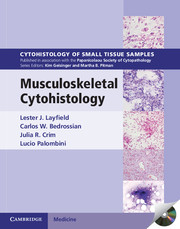Book contents
- Frontmatter
- Contents
- 1 Principles and practice for biopsy diagnosis and management of musculoskeletal lesions
- 2 Ancillary techniques useful in the evaluation and diagnosis of bone and soft tissue neoplasms
- 3 Spindle cell tumors of bone and soft tissue in infants and children
- 4 Spindle cell tumors of the musculoskeletal system characteristically occurring in adults
- 5 Giant cell tumors of the musculoskeletal system
- 6 Myxoid lesions of bone and soft tissue
- 7 Lipomatous tumors
- 8 Vascular tumors of bone and soft tissue
- 9 Pleomorphic sarcomas of bone and soft tissue
- 10 Osseous tumors of bone and soft tissue
- 11 Cartilaginous neoplasms of bone and soft tissue
- 12 Small round cell neoplasms of bone and soft tissue
- 13 Epithelioid and polygonal cell tumors of bone and soft tissue
- 14 Cystic lesions of bone and soft tissue
- Index
11 - Cartilaginous neoplasms of bone and soft tissue
Published online by Cambridge University Press: 05 September 2013
- Frontmatter
- Contents
- 1 Principles and practice for biopsy diagnosis and management of musculoskeletal lesions
- 2 Ancillary techniques useful in the evaluation and diagnosis of bone and soft tissue neoplasms
- 3 Spindle cell tumors of bone and soft tissue in infants and children
- 4 Spindle cell tumors of the musculoskeletal system characteristically occurring in adults
- 5 Giant cell tumors of the musculoskeletal system
- 6 Myxoid lesions of bone and soft tissue
- 7 Lipomatous tumors
- 8 Vascular tumors of bone and soft tissue
- 9 Pleomorphic sarcomas of bone and soft tissue
- 10 Osseous tumors of bone and soft tissue
- 11 Cartilaginous neoplasms of bone and soft tissue
- 12 Small round cell neoplasms of bone and soft tissue
- 13 Epithelioid and polygonal cell tumors of bone and soft tissue
- 14 Cystic lesions of bone and soft tissue
- Index
Summary
INTRODUCTION
Cartilaginous neoplasms of bone and soft tissues are relatively common. Osteochondromas and chondromas are the first and second most common benign neoplasms of bone. Chondrosarcomas are the second most common primary sarcoma of bone following osteosarcoma. Cartilage forming neoplasms display a wide range of morphologies and clinical behaviors ranging from totally benign osteochondromas and chondromas to very aggressive grade III chondrosarcomas. While osteochondromas and chondromas are benign neoplasms, both have the potential for malignant degeneration. These two neoplasms also occur as inherited multifocal forms represented by Ollier’s disease, Maffucci syndrome, and osteochondromatosis.
Cartilaginous neoplasms are associated with some of the most difficult differential diagnoses in musculoskeletal pathology. The separation of enchondroma from grade I chrondrosarcoma can be exceedingly difficult requiring integration of clinical, radiographic, and histopathologic data.
CHONDROMA AND ITS VARIATIONS
Clinical features
Chondromas represent benign proliferations of cartilage which account for 10% of all benign bone tumors and may vary considerably in appearance depending on patient age, site of origin, and whether or not a syndrome is present. Chondromas are subdivided into enchondromas, periosteal, or parosteal chondromas, and extraskeletal chondromas. Enchondromas are, by far, the most common.
- Type
- Chapter
- Information
- Musculoskeletal Cytohistology , pp. 220 - 246Publisher: Cambridge University PressPrint publication year: 2000

